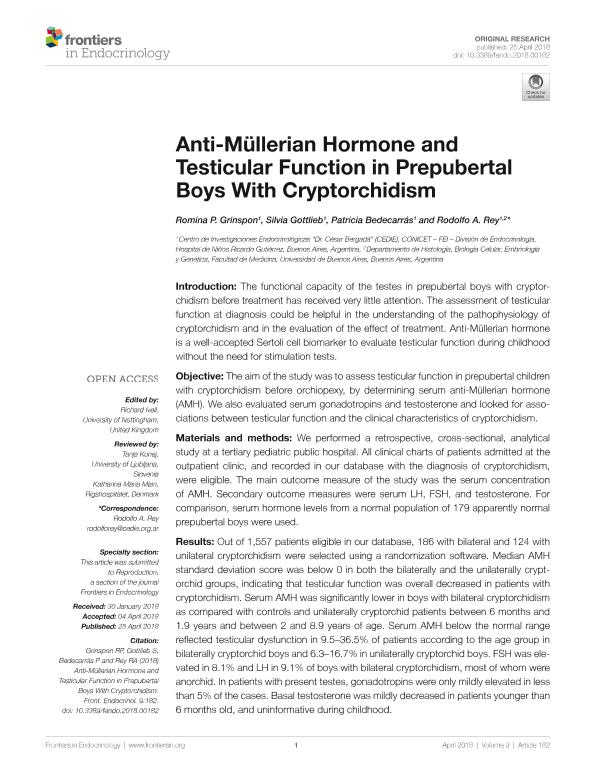Mostrar el registro sencillo del ítem
dc.contributor.author
Grinspon, Romina

dc.contributor.author
Gottlieb, Silvia Elisa

dc.contributor.author
Bedecarras, Patricia Gladys

dc.contributor.author
Rey, Rodolfo Alberto

dc.date.available
2019-11-29T22:35:26Z
dc.date.issued
2018-04
dc.identifier.citation
Grinspon, Romina; Gottlieb, Silvia Elisa; Bedecarras, Patricia Gladys; Rey, Rodolfo Alberto; Anti-Müllerian Hormone and Testicular Function in Prepubertal Boys With Cryptorchidism; Frontiers Research Foundation; Frontiers in Endocrinology; 9; APR; 4-2018; 1-15
dc.identifier.issn
1664-2392
dc.identifier.uri
http://hdl.handle.net/11336/91053
dc.description.abstract
Introduction: The functional capacity of the testes in prepubertal boys with cryptorchidism before treatment has received very little attention. The assessment of testicular function at diagnosis could be helpful in the understanding of the pathophysiology of cryptorchidism and in the evaluation of the effect of treatment. Anti-Müllerian hormone is a well-accepted Sertoli cell biomarker to evaluate testicular function during childhood without the need for stimulation tests. Objective: The aim of the study was to assess testicular function in prepubertal children with cryptorchidism before orchiopexy, by determining serum anti-Müllerian hormone (AMH). We also evaluated serum gonadotropins and testosterone and looked for associations between testicular function and the clinical characteristics of cryptorchidism. Materials and methods: We performed a retrospective, cross-sectional, analytical study at a tertiary pediatric public hospital. All clinical charts of patients admitted at the outpatient clinic, and recorded in our database with the diagnosis of cryptorchidism, were eligible. The main outcome measure of the study was the serum concentration of AMH. Secondary outcome measures were serum LH, FSH, and testosterone. For comparison, serum hormone levels from a normal population of 179 apparently normal prepubertal boys were used. Results: Out of 1,557 patients eligible in our database, 186 with bilateral and 124 with unilateral cryptorchidism were selected using a randomization software. Median AMH standard deviation score was below 0 in both the bilaterally and the unilaterally cryptorchid groups, indicating that testicular function was overall decreased in patients with cryptorchidism. Serum AMH was significantly lower in boys with bilateral cryptorchidism as compared with controls and unilaterally cryptorchid patients between 6 months and 1.9 years and between 2 and 8.9 years of age. Serum AMH below the normal range reflected testicular dysfunction in 9.5-36.5% of patients according to the age group in bilaterally cryptorchid boys and 6.3-16.7% in unilaterally cryptorchid boys. FSH was elevated in 8.1% and LH in 9.1% of boys with bilateral cryptorchidism, most of whom were anorchid. In patients with present testes, gonadotropins were only mildly elevated in less than 5% of the cases. Basal testosterone was mildly decreased in patients younger than 6 months old, and uninformative during childhood. Conclusion: Prepubertal boys with cryptorchidism, especially those with bilaterally undescended gonads, have decreased AMH production. Although serum AMH may fall within the normal range, there is a considerable prevalence of testicular dysfunction during childhood in this frequent condition.
dc.format
application/pdf
dc.language.iso
eng
dc.publisher
Frontiers Research Foundation

dc.rights
info:eu-repo/semantics/openAccess
dc.rights.uri
https://creativecommons.org/licenses/by-nc-sa/2.5/ar/
dc.subject
ANTI-MÜLLERIAN HORMONE
dc.subject
GONADOTROPINS
dc.subject
HYPOGONADISM
dc.subject
SERTOLI CELLS
dc.subject
TESTOSTERONE
dc.subject
UNDESCENDED TESTES
dc.subject.classification
Endocrinología y Metabolismo

dc.subject.classification
Medicina Clínica

dc.subject.classification
CIENCIAS MÉDICAS Y DE LA SALUD

dc.title
Anti-Müllerian Hormone and Testicular Function in Prepubertal Boys With Cryptorchidism
dc.type
info:eu-repo/semantics/article
dc.type
info:ar-repo/semantics/artículo
dc.type
info:eu-repo/semantics/publishedVersion
dc.date.updated
2019-10-16T15:09:09Z
dc.journal.volume
9
dc.journal.number
APR
dc.journal.pagination
1-15
dc.journal.pais
Suiza

dc.description.fil
Fil: Grinspon, Romina. Consejo Nacional de Investigaciones Científicas y Técnicas. Oficina de Coordinación Administrativa Parque Centenario. Centro de Investigaciones Endocrinológicas "Dr. César Bergada". Gobierno de la Ciudad de Buenos Aires. Centro de Investigaciones Endocrinológicas "Dr. César Bergada". Fundación de Endocrinología Infantil. Centro de Investigaciones Endocrinológicas "Dr. César Bergada"; Argentina
dc.description.fil
Fil: Gottlieb, Silvia Elisa. Consejo Nacional de Investigaciones Científicas y Técnicas. Oficina de Coordinación Administrativa Parque Centenario. Centro de Investigaciones Endocrinológicas "Dr. César Bergada". Gobierno de la Ciudad de Buenos Aires. Centro de Investigaciones Endocrinológicas "Dr. César Bergada". Fundación de Endocrinología Infantil. Centro de Investigaciones Endocrinológicas "Dr. César Bergada"; Argentina
dc.description.fil
Fil: Bedecarras, Patricia Gladys. Consejo Nacional de Investigaciones Científicas y Técnicas. Oficina de Coordinación Administrativa Parque Centenario. Centro de Investigaciones Endocrinológicas "Dr. César Bergada". Gobierno de la Ciudad de Buenos Aires. Centro de Investigaciones Endocrinológicas "Dr. César Bergada". Fundación de Endocrinología Infantil. Centro de Investigaciones Endocrinológicas "Dr. César Bergada"; Argentina
dc.description.fil
Fil: Rey, Rodolfo Alberto. Consejo Nacional de Investigaciones Científicas y Técnicas. Oficina de Coordinación Administrativa Parque Centenario. Centro de Investigaciones Endocrinológicas "Dr. César Bergada". Gobierno de la Ciudad de Buenos Aires. Centro de Investigaciones Endocrinológicas "Dr. César Bergada". Fundación de Endocrinología Infantil. Centro de Investigaciones Endocrinológicas "Dr. César Bergada"; Argentina
dc.journal.title
Frontiers in Endocrinology
dc.relation.alternativeid
info:eu-repo/semantics/altIdentifier/url/http://journal.frontiersin.org/article/10.3389/fendo.2018.00182/full
dc.relation.alternativeid
info:eu-repo/semantics/altIdentifier/doi/http://dx.doi.org/10.3389/fendo.2018.00182
Archivos asociados
